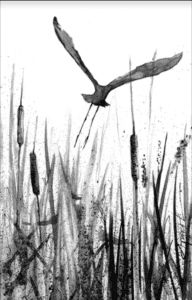Sunlight glinted off the water as we paddled our canoe along a winding channel which led through a marsh of tall grasses and wild rice. Two white, long-legged birds – great egrets – stalked the shallow water, poised to spear fish with their pointed bills. A bald eagle landed in a tree, squawking as it joined its mate. After four miles of canoeing down the Missisquoi River in northwestern Vermont we had reached the point where the river enters Lake Champlain.
Along the river we passed an array of marshes – shallow emergent marsh, cattail marsh, deep bulrush marsh, wild rice marsh – a vast mosaic that makes up much of Missisquoi National Wildlife Refuge. Marshes are open wetlands with soft-stemmed vegetation, where saturated soils or standing water prevent most shrubs and trees from growing. These wetlands are rich in biodiversity.

Marsh plants have special adaptations that enable them to survive the wet conditions. For example, cattails and arrowhead can exchange gases between their emergent leaves and submerged roots. The type of vegetation that grows in a particular marsh depends on hydrology and soil. In shallow marshes, the water level varies from just a few inches to a foot deep. The soil may be always saturated, or it may be flooded periodically. Deeper marshes are permanently flooded, with large areas of open water. Marsh soils range from decomposed muck to high-organic mineral soil. Along the edges of lakes, ponds, and rivers, marsh vegetation often grows in distinct bands, influenced by water depth and exposure. Sedges, for example, will grow in moist to saturated soil. Cattails and pickerelweed, with its distinctive stems of purple flowers, prefer standing water through most of the growing season. Aquatic bulrush and wild rice are found in deeper water.
These and several other plants, such as floating duckweed and arrow arum, form the foundation of the marsh food web. Waterfowl and other birds feed on the plants’ seeds, fruit, and vegetation, and the plants’ decomposed remains nourish a host of invertebrates such as snails, worms, crayfish, and insects. The invertebrates in turn provide food for frogs, fish, turtles, and songbirds, which feed water snakes, raccoons, herons, osprey, and bald eagles, among others. Muskrats are common marsh residents, eating the rhizomes (roots) of cattails and water lilies and building their dome-shaped winter lodges with cattail leaves. Mink slide through the lodges’ underwater entrances to prey on muskrats. Many birds, including hard-to-see bitterns, nest in marshes, and red-winged blackbirds often attach their nests to old cattail stalks.
On our journey down the Missisquoi River, we were amazed at the sheer abundance of wildlife, nourished in part by the refuge’s marshes. Around every bend we found great blue herons, stalking prey in shallow water. When startled, these large birds would take off, their huge wings flapping ponderously. Kingfishers flew out from the trees, making their rattling calls. Freshwater mussels were visible underwater, sticking out of the silt on the bottom. A green heron, its long neck folded back onto its shoulders, rocketed across the river in front of our bow.
In addition to providing outstanding wildlife habitat, freshwater marshes perform several vital ecological functions. Marsh plants capture sediments running off the land from roads, development, and farm fields and filter out excess nutrients that would otherwise degrade water quality. These wetlands store floodwaters, control erosion, and recharge groundwater supplies. Marshes also offer recreational value and are popular places for paddling, birdwatching, hunting, and fishing.
Unfortunately, only in recent decades have people recognized the value of marshes and other wetlands and, to some extent, given them legal protection. Since European settlement, many marshes have been filled for agriculture or development, polluted by industrial run-off, or converted to ponds or lakes by dams. In some locales, there have been restoration efforts, but it is challenging to replicate a natural marsh, although beaver activity can create new marshes or change them to create other forms of wetlands.
Late summer is a great time to explore a marsh, especially as early migrating birds make use of this habitat. Easy-to-access marshes to visit include The Nature Conservancy’s LaPlatte River Marsh Natural Area in Shelburne, Vermont, the Chaffee Wildlife Sanctuary in Lyme, New Hampshire, where there are nature trails, and McDaniels Marsh Wildlife Management Area in Grafton, New Hampshire, accessible by boat.
Susan Shea is a naturalist, writer, and conservationist based in Vermont. Illustration by Adelaide Murphy Tyrol. The Outside Story is assigned and edited by Northern Woodlands magazine and sponsored by the Wellborn Ecology Fund of the New Hampshire Charitable Foundation: nhcf.org.




